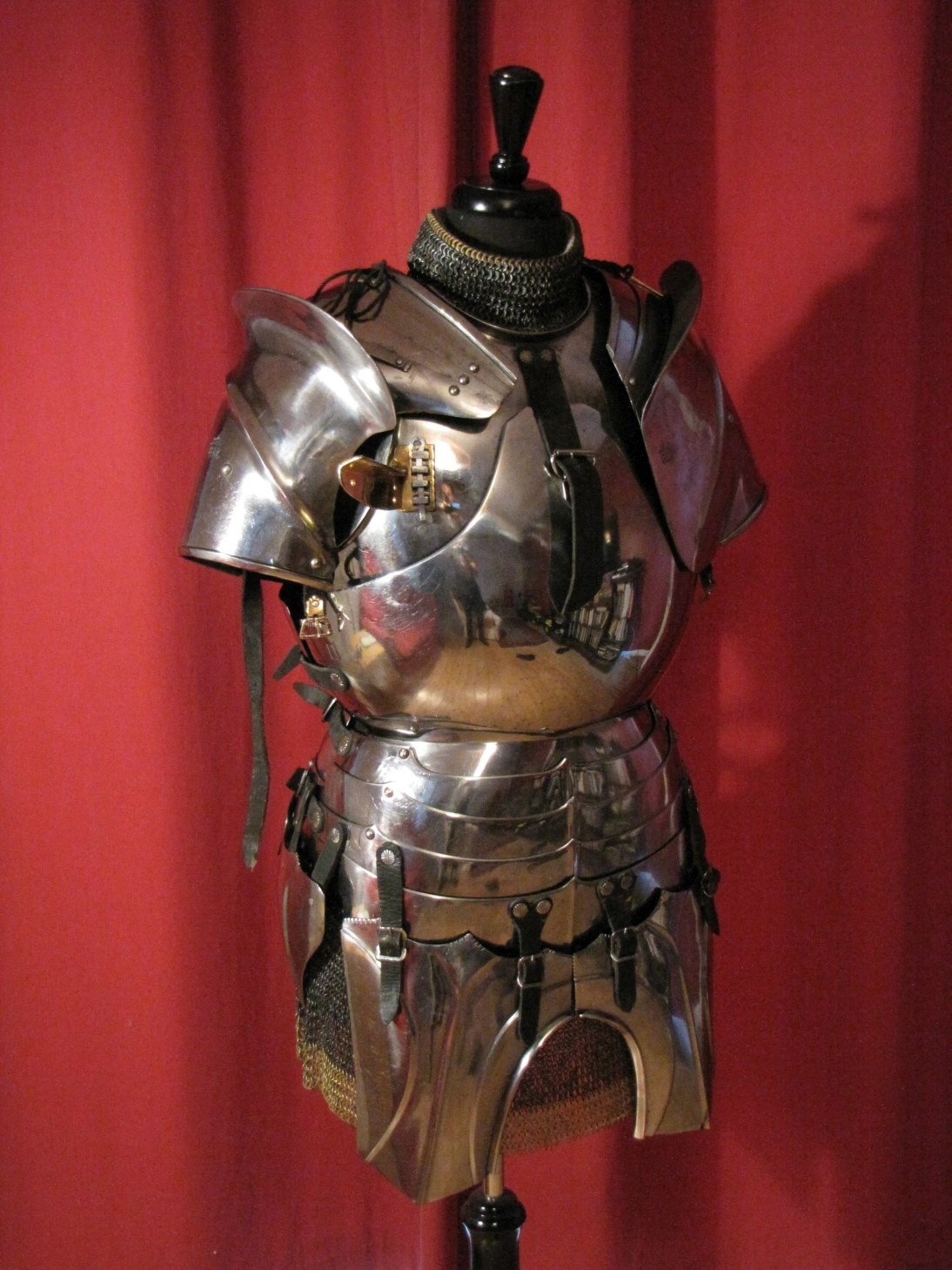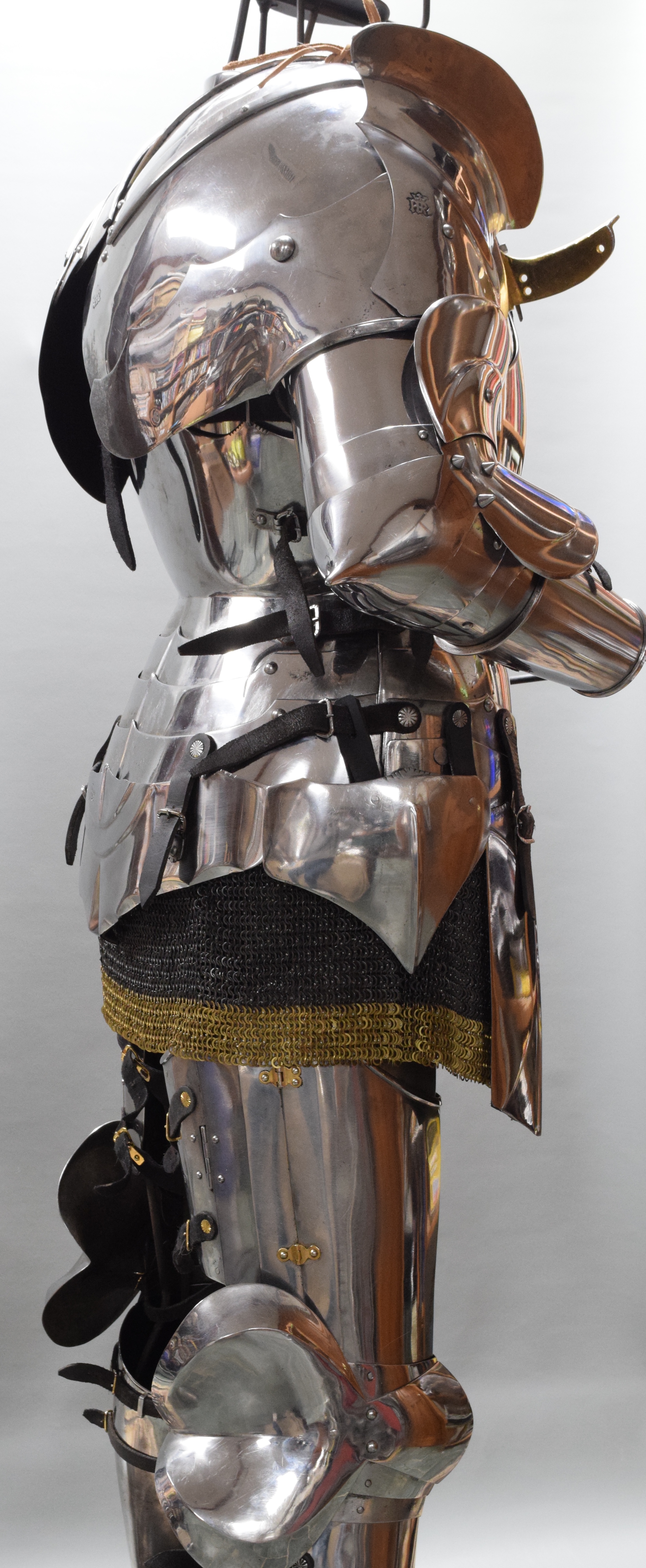


























Italian armour in the western European style 1465
An extremely fine replica harness comprising armet, cuirass, mail collar, pauldrons arms, cuisses, greaves and gauntlets as they would have been built in Italy c. 1465. Made of hardened and tempered steel. The armour was assembled over time and purchased from various skilled armourers. It was adapted as required for wear in a very Italian form (with additional mail elements) and later in a more western European form. The armet was built originally as part of the project to explore English armour of the mid 15th c. and then used along with the rest to build a heavy calvalry armour first in the typical Italian style, then in a more western European or English style. The cuirass precisely reproduces the authentic shapes, thicknesses and weights of fifteenth-century Italian heavy cavalry armour, with a shot-proof breastplate and skirt, and mounted with a gilded lance-rest. Buckles and mounts gilt to match. Together with a matching pair of pauldrons and arms. The design of the cuirass, pauldrons and arms has been taken from two surviving Italian export armours in Switzerland, at the Bern Historical Museum and the Town Museum, Le Landeron. Cuisses were made in 2009. They were based on the cuisses currently displayed as part of the B1 armour in Mantova. The greaves were made separately, probably earlier, and the lower plate of the cuisse was adjusted to fit. The cuisses and greaves were originally fitted with mail in the Italian fashion (comprising a valence below the knee and full mail sabatons). The instep edge of the greaves are pierced for the attachment of the mail and the lower plate of the poleyne had a strip with holes to secure mail below the knee. At this time the mail has been removed for the western European fashion. Gauntlets were based off one in the Metropolitan Museum of Art in New York which is on display - 29.150.7j. The armourer was able to look at it and make tracings. Gauntlets were made in the summer of 2012. Toby supplied the buff gloves.
Cuirass, pauldrons and arms made by Per Lillelund Jensen. Cuisses, greaves and gauntlets made by Jeff Wasson to accompany the other pieces. This was most commonly worn with an armet made by Robert MacPherson in 2003. The armet is mostly a typical Italian style of the mid 15th c. but the visor is slightly adapted to represent a more English form.
The left elbow was adapted to match the hind tasset and to reflect an English usage as illustrated in the Hoo effigy. The armour was built as another experimental armour after the famous English armour built by Mac. This armour was worn for several years in jousts around the world and it was the armour that Toby wore as part of the work associated with Richard III's reburial and the work to recreate an armour for Richard III. Overall the armour survived its years in use very well. There seems to be one small dent in the left side of the lower breastplate, it has undergone various adaptations, and leathers have been replaced and pieces adapted as the wearer changed shape. Inspection of the left gauntlet cuff shows two points of damage. They come from one blow from a steel coronel on a solid wooden lance in the jousts at Schaffhausen when a blow went just a little low and two tynes of the coronel hit the guantlet.
The armour was purchased by the present owner in three parts. The first comprised the cuirass, pauldrons and arms. After that the legs and gauntlets became available and they were purchased to keep the harness together. The final part was the armet with some associated pieces. The harness was originally assembled over time as the parts were needed and made by armourers with the requisite skills and experience. Italian 15th c. armours, even when purchased as an armour, were often built by several armourers. At some point Toby had a new doublet made, so the one worn with this harness was also added to the collection. This doublet was worn with incarnations 6.3 and 6.4 of Toby's armour progression covering app. 2014-2016. It was made by Ninya Mikhaila and is one of a series she has made for Toby. It is covered in black wool with relevant arming points and cut to fit at the hips to allow for the suspesion of the legs and to allow full movement.
For a while (between the time the first and second portions were purchased) displayed with the legs that formerly formed part of R-15 made by Wade Allen in the mid 1990's. They are a fair match for the style of armour represented by the rest of the pieces. Armet manufactured by Robert MacPherson with riveted aventail made by Tobias Capwell which includes a wrapper. Then an exchange visor for foot combat was added (manufactured by Chris Dobson). The armet includes a gilded and pearl-fretted claw ornament which acts as a crest or plume mount which was built as part of the original English armour project by Robert Macpherson. Burgundian style upper arm voiders made by Toby in the Burgundian style and an arming doublet which illustrates how the small Burgundian voiders were worn. When the legs were re-fitted for Burgundian use the valences for mail were removed (valences present) and the shorter mail demi-sabatons are also present but not attached.
If you have any questions, please send them to Wade Allen
This site last updated Wed Apr 13 19:23:17 EDT 2022